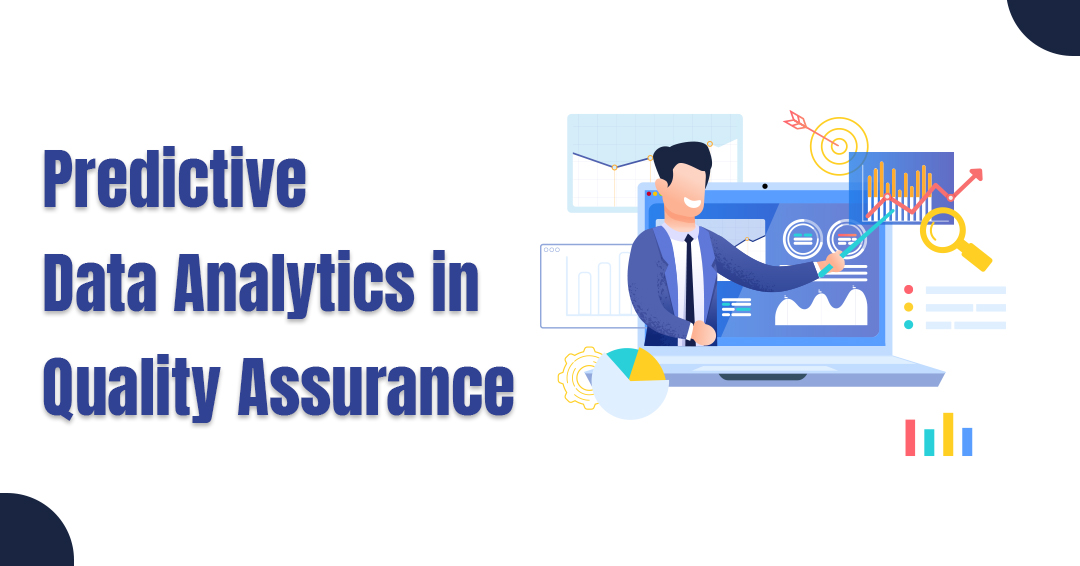Data plays a central role in business decision-making, and predictive data analytics is a powerful tool that enhances this process. As a key component of data analytics, predictive analytics helps businesses anticipate future outcomes, identify potential risks, recommend strategies for mitigation, and ultimately drive profitability. Its growing importance lies in its ability to provide insights that lead to better decision-making and more efficient operations.
So, how exactly does predictive data analytics influence software quality assurance services? In what ways can it transform the QA process? And why should businesses consider integrating predictive data analytics into their testing workflows? Let’s dive in and explore more!
Predictive Data Analytics Defined
Predictive data analytics involves leveraging data to anticipate future outcomes. It uncovers patterns that can predict upcoming behaviors using data analysis, machine learning, artificial intelligence, and statistical models. This approach allows organizations to use both historical and real-time data to make highly accurate predictions. It helps foresee potential challenges and take proactive measures based on data-backed insights.
How Does Predictive Analytics Work?
Data scientists make use of predictive models to uncover relationships between various elements within selected datasets. After gathering the necessary data, a statistical model is developed, trained, and refined to make accurate predictions. The process of building predictive analytics frameworks typically follows five key steps:
Define the Problem: A prediction begins with a clear objective and defined requirements. A well-defined problem guides the selection of the appropriate predictive analytics method.
Collect and Organise Data: An organization may have years of data or a continual stream of data from customer interactions. Before developing predictive analytics models, it’s crucial to identify data flows and organize the datasets into a central repository.
Process the Data: Raw data has limited value on its own. To make it suitable for predictive analytics, it must be cleaned to eliminate anomalies, missing values, and extreme outliers, which could stem from input or measurement errors.
Develop Predictive Models: Data scientists use various tools and techniques to develop predictive models, depending on the problem and dataset. Common types include machine learning, regression models, and decision trees.
Validate and Deploy Results: Assess the model’s accuracy and make necessary adjustments. Once the results meet expectations, share them with stakeholders through an app, website, or data dashboard.
Predictive Data Analytics Types
Predictive analytics models are tailored to address various needs, with each model optimized for specific data patterns, business objectives, and testing conditions. Here are some of the main types of predictive models used in software testing:
Classification Model – Uses historical data to develop algorithms that categorize datasets into distinct classes.
Regression Model – This model is designed to analyze only quantitative variables.
Decision Trees – Offers simplicity and clarity, visually representing potential outcomes.
Cluster Model – Applies clustering to group similar data types, known as clusters, and uncover patterns and trends within each group.
Neural Network – Advanced predictive analytics technique similar to the pattern recognition mechanisms of the human brain.
Why Use Predictive Analytics in QA & Software Testing Process?
With advancements in Big Data, AI, and Machine Learning, predictive analytics has become essential for testers and QAs. It enables teams to proactively predict and address potential issues, unlike traditional methods that react only after problems arise. Here’s why predictive analytics is vital for QAs:
Enhanced Customer Satisfaction: Predictive analytics leverages customer data to identify patterns in product usage. By pinpointing critical usage flows, teams can design test cases targeting essential functions. This ensures testing aligns with actual user needs and offers valuable insights into customer behaviors and preferences.
Proactive Defect Detection: Early identification of defects improves product quality while saving time and reducing costs. By analyzing historical production failures, predictive analytics helps pinpoint areas prone to errors, enabling teams to address potential issues before they arise.
Accelerated Time-to-Market: By prioritizing testing efforts on actual customer usage rather than just business requirements, teams can improve efficiency and reduce unnecessary costs. Focusing on critical areas minimizes test cycle duration, allowing quicker feature releases. Predictive insights into defect-prone areas further streamline the process, ensuring faster delivery.
Improved Release Control: Predictive models assist in monitoring timelines and foreseeing potential delays, ensuring a smoother release process. By identifying risks early and addressing underlying issues promptly, teams can make timely adjustments, keep projects on schedule, and ensure reliable releases.
Predictive Analytics in Software Testing: Use Cases
Here are some practical applications of predictive analytics in software testing:
Release Quality Forecasting:
In software development, maintaining high-release quality is crucial for preserving user trust and safeguarding a company’s reputation. Powered by AI, predictive analytics offers a cutting-edge approach to assessing release quality.
By examining historical data from past releases, including defect rates, issue severity, and customer feedback, AI can accurately predict potential issues in future releases, allowing for more proactive decision-making.
Test Case Prioritization:
It is crucial to prioritize testing efforts in an environment where resources are often limited. Predictive analytics can help in finding the test cases that are most likely to reveal flaws. Artificial intelligence models can rank test cases intelligently by examining factors like failure likelihood, recent code modifications, and historical defect trends.
Performance Prediction:
The effectiveness of the application depends on how well the system performs when it is under load. Analyzing user-generated load and assessing the system’s reaction time under varied circumstances are both part of performance testing. The goal of predictive analytics in software testing is to foresee future needs in real-time.
It’s even possible to forecast how well an application will function in various scenarios by using predictive analytics models.
Summing Up
As businesses increasingly rely on predictive data analytics to inform their decision-making, collaborating with a software development company that specializes in AI development services is key to leveraging the full potential of this technology. Predictive analytics is transforming software testing by enabling teams to move from reactive bug fixes to proactive ones. For businesses seeking to enhance their testing processes and ensure the highest quality of software products, working with a software testing company in Canada that offers the best QA consulting services can make a significant difference. You can also choose to hire developers if you lack in-house team expertise. Embrace the power of predictive data analytics to optimize your software testing process, reduce defects, and develop user-focused products with exceptional efficiency. Have any queries? Feel free to contact us!









